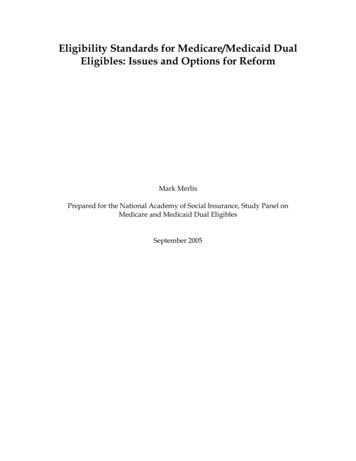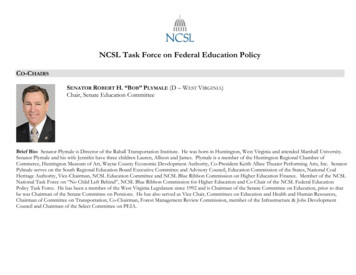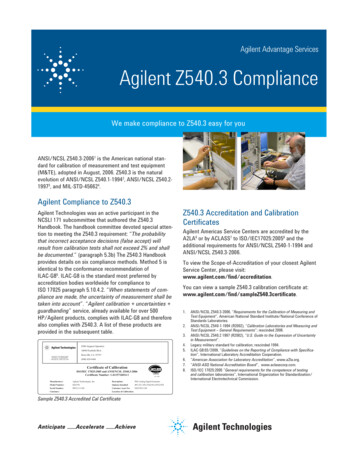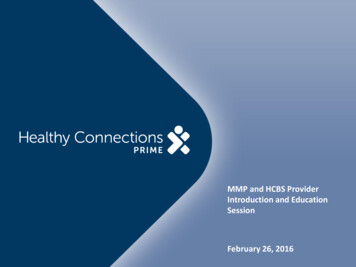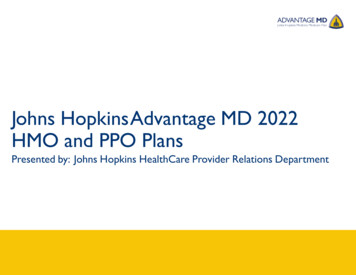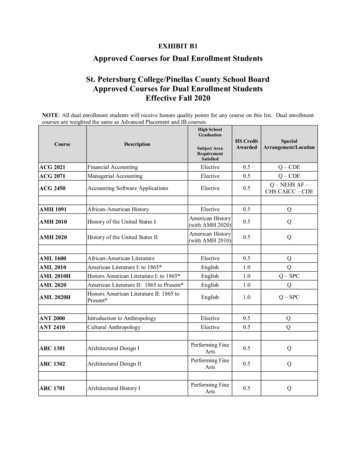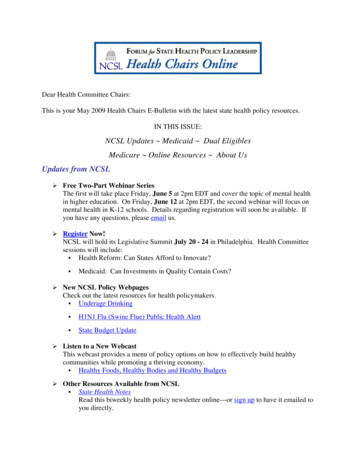
Transcription
Dear Health Committee Chairs:This is your May 2009 Health Chairs E-Bulletin with the latest state health policy resources.IN THIS ISSUE:NCSL Updates Medicaid Dual EligiblesMedicare Online Resources About UsUpdates from NCSL¾ Free Two-Part Webinar SeriesThe first will take place Friday, June 5 at 2pm EDT and cover the topic of mental healthin higher education. On Friday, June 12 at 2pm EDT, the second webinar will focus onmental health in K-12 schools. Details regarding registration will soon be available. Ifyou have any questions, please email us.¾ Register Now!NCSL will hold its Legislative Summit July 20 - 24 in Philadelphia. Health Committeesessions will include: Health Reform: Can States Afford to Innovate? Medicaid: Can Investments in Quality Contain Costs?¾ New NCSL Policy WebpagesCheck out the latest resources for health policymakers. Underage Drinking H1N1 Flu (Swine Flue) Public Health Alert State Budget Update¾ Listen to a New WebcastThis webcast provides a menu of policy options on how to effectively build healthycommunities while promoting a thriving economy. Healthy Foods, Healthy Bodies and Healthy Budgets¾ Other Resources Available from NCSL State Health NotesRead this biweekly health policy newsletter online—or sign up to have it emailed toyou directly.
Capitol IdeasRefer to this compilation of top policy issues influencing state legislatures. Themost recent issue includes:oPlanning for pandemic fluoKeeping kids safe onlineoPromoting healthy communities to reduce childhood obesityPublic Health HeraldTake a look at this quarterly health and wellness policy messenger. The most recentissue focuses on tobacco use.MedicaidGetting the Most for Your As the number of Medicaid beneficiaries increases, states are looking for new ways to maximizethe impact of available funds. The Commonwealth Fund recently released Maximizing Qualityand Value in Medicaid, which examines how return-on-investment (ROI) analyses can improvequality and control costs in Medicaid. Policymakers seeking to develop value-driven strategiesfor containing growth of costs over time can use ROI forecasting to help identify program andinfrastructure investments that have potential to generate downstream reductions in health carespending.Source: The Commonwealth Fund
Variations in P4P ModelsWith 63 million beneficiaries—66 percent of whom are in managed care—and more than 361billion in annual expenditures, state Medicaid programs are in an excellent position to impactquality at the point of care and to foster greater alignment across health plans and deliverysystems. The Center for Health Care Strategies, Inc.'s Provider Incentive Programs: AnOpportunity for Medicaid to Improve Quality at the Point of Care presents examples of howstates are becoming more involved in the pay-for-performance (P4P) at the practice level.Although P4P is just one tool available to states to improve quality, Medicaid programs can playan important role in creating much needed alignment in P4P.Managed Care and Federally Qualified Health CentersThe National Academy for State Health Policy's Policies and Strategies to Make MedicaidManaged Care Work for FQHCs compares the managed care policies in Alabama and Michiganwith regard to enrollment, access, quality and financing. The brief finds that strongcommunication between state Medicaid agencies, public health departments, FQHCs and otherstakeholders is key to providing health care to vulnerable populations.Increasing Enrollment of Eligible ChildrenBecause many states are working to increase enrollment of eligible children in public healthcoverage programs, the National Academy for State Health Policy also recently publishedMaximizing Kids' Enrollment in Medicaid and SCHIP to provide states with the most effectiveapproaches for enrolling eligible children. The paper's recommendations include simplifyingenrollment and renewal procedures, utilizing community-based outreach, using technology tocoordinate programs and reduce administrative burdens, and identifying effective marketingstrategies.
Dual EligiblesA State-by-State Look at DualsThe Kaiser Commission on Medicaid and the Uninsured recently published three issue briefsconcerning the population of individuals dually-eligible for Medicare and Medicaid coverage.Where Does the Burden Lie? Medicaid and Medicare Spending for Dual Eligible Beneficiariesfinds that states spend four times more to provide coverage for dual eligibles than on non-duals.For these beneficiaries, Medicare covers most acute care services, while Medicaid pays for themajority of long-term care services.Dual Eligibles: Medicaid Enrollment and Spending for Medicare Beneficiaries in 2005 providesa variety of statistics on dual eligibles in all 50 states, including the total number of dualeligibles, the number of aged and disabled duals, and Medicaid expenditures on this population.Rethinking Medicaid's Financing Role for Medicare Enrollees examines the fiscal impacts ofdifferent options for restructuring the federal-state financing relationship for duals. The optionsinclude federal assumption for the financing of Medicare premiums, Medicaid acute careservices or all long-term care services.
Difficulty in Providing Coverage for DualsFollowing a recent meeting on understanding Medicare and Medicaid, the National HealthPolicy Forum made available two presentations on Medicare-Medicaid Dual Eligibles. Judith D.Moore, Senior Fellow from the Forum, presented Two Programs, Twice the Challenge?, whichexamined the differences in the payment systems used by Medicare and Medicaid. Thepresentation asserted that the lack of coordination of care between the two programs leads tohealth care that is fragmented, inefficient and costly, which creates incentives for cost shifting.Barbara Coulter Edwards, Principal of Health Management Associates, presented StateImperative and Federal Opportunity, which reiterates that dual eligibles are the sickest, mostvulnerable and most expensive population and are least likely to have coordinated, cost-effectivecare. According to Edwards, financial incentives for Medicare and Medicaid are not properlyaligned, and because Medicaid is a secondary payer, improved primary and acute care is difficultto accomplish. Although many states enroll their aged, blind and disabled population intomanaged care plans, most exclude dual eligibles, resulting in fragmented care.NCSL recently covered the topic of dual eligibles in State Health Notes.MedicareEnrolling Eligible SeniorsMany low-income seniors eligible for Medicare Saving Programs do not participate oftenbecause they are not familiar with the programs or are discouraged by the complexity of theenrollment process. The Commonwealth Fund's Increasing Participation in Benefit Programsfor Low-Income Seniors identifies effective methods to increase enrollment, including aligningeligibility rules and enrollment procedures, using a person-centered, one-on-one approach foroutreach and enrollment, investing in information technology, and providing financial supportfor ongoing outreach and enrollment activities.Variations in SpendingThe Dartmouth Institute for Health Policy & Clinical Practice's The Policy Implications ofVariations in Medicare Spending Growth finds that between 1992 and 2006 Medicare spending,adjusted for general price inflation, rose 3.5 percent annually. However, there was considerablevariation among different regions across the country. Per capita, inflation-adjusted spending inMiami, Florida grew at 5 percent annually, compared to just 2.3 percent in Salem, Oregon and2.4 percent in San Francisco, California. The brief explains that there is no single reason for thisgrowth but rather multiple factors—including differences in availability of technology, capitaland resources, as well as variations in payment systems—contribute to the growth.
Source: Dartmouth Atlas ProjectMedicare Beneficiaries FactsA recently released fact sheet by the AARP Public Policy Institute reports that 15 percent of theU.S. population (44 million) is currently enrolled in Medicare and this population is expected toincrease to 70 million by 2030. The Medicare Beneficiary Population Fact Sheet also finds thatonly one in 10 beneficiaries relies solely on the Medicare program for health care coverage.Most have supplemental coverage to help with medical expenses. Almost half of beneficiarieshave incomes below 200 percent of the federal poverty level.Other Online ResourcesSCHIP & Medicaid Statistics by StateAn online interactive map provides the Estimated Number of Children Enrolled in SCHIP bystate. The Kaiser Family Foundation also provides additional resources on topics such asMedicaid spending, temporary federal Medicaid relief, and Medicaid budget actions.Returns on Public Health InvestmentsThe Center for Health Care Strategies recently created the Return on Investment (ROI)Calculator for Quality Initiatives. This online calculator allows policymakers and stakeholdersto forecast ROIs based on intervention strategies, size of targeted population and estimatedprogram costs. Accompanying the calculator is a User's Guide on best practices.Interactive Map of Pre-Existing ConditionsThe Center for American Progress provides an interactive map on pre-existing conditions,including high blood pressure, asthma and diabetes. Because millions of Americans with theseconditions often experience difficulties in obtaining health insurance coverage, the Centerrecommends preventing insurers from denying coverage based on medical history.
About UsThe National Conference of State Legislatures is a bipartisan organization that serves thelegislators and staffs of the nation's 50 states, commonwealths and territories, providing research,technical assistance, and opportunities for policymakers to exchange ideas on the most pressingstate issues.Located in NCSL's Washington, DC office, the Forum for State Health Policy Leadershipworks with state legislators and staff to identify critical health policy issues and address thechallenges in developing effective state policy.Established by the Forum, the Health Chairs Project serves the health committee chairs of all50 states by providing educational materials on health policy issues, direct access to policyexperts and the opportunity to share information and discuss policy strategies among other healthchairs.The Health Chairs E-Bulletin is a monthly email that provides an overview of newdevelopments concerning topics in health, resources that may be helpful in developing policy,and updates on the Health Chairs Project, the Forum, and NCSL.Missed an issue? Visit the Chairs E-bulletins archives.Have a great state health policy resource? Please email us to include it in the next issue.See you in June!Donna FolkemerGroup Director202-624-8171Donna.Folkemer@ncsl.orgAnna WolkePolicy Associate202-624-3571Anna.Wolke@ncsl.orgRobin RichardsonPolicy onal Conference of State Legislatures444 N. Capitol Street, N.W., Suite 515Washington, D.C. 20001
aligned, and because Medicaid is a secondary payer, improved primary and acute care is difficult to accomplish. Although many states enroll their aged, blind and disabled population into . The Medicare Beneficiary Population Fact Sheet also finds that only one in 10 beneficiaries relies solely on the Medicare program for health care coverage.
